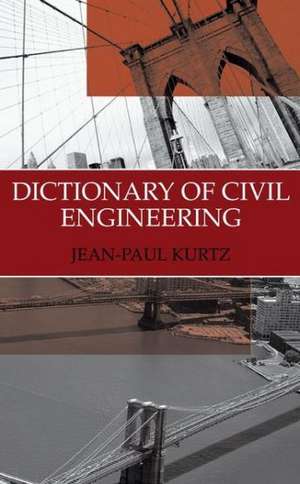Dictionary of Civil Engineering: English-French
Editat de Jean-Paul Kurtzen Limba Engleză Paperback – mai 2013
| Toate formatele și edițiile | Preț | Express |
|---|---|---|
| Paperback (1) | 884.01 lei 38-45 zile | |
| Springer Us – mai 2013 | 884.01 lei 38-45 zile | |
| Hardback (1) | 891.48 lei 38-45 zile | |
| Springer Us – 13 sep 2004 | 891.48 lei 38-45 zile |
Preț: 884.01 lei
Preț vechi: 1163.16 lei
-24% Nou
Puncte Express: 1326
Preț estimativ în valută:
169.15€ • 177.56$ • 140.40£
169.15€ • 177.56$ • 140.40£
Carte tipărită la comandă
Livrare economică 07-14 aprilie
Preluare comenzi: 021 569.72.76
Specificații
ISBN-13: 9781475787528
ISBN-10: 1475787529
Pagini: 1528
Ilustrații: X, 1515 p. In 2 volumes, not available separately.
Dimensiuni: 155 x 235 x 86 mm
Greutate: 0 kg
Ediția:2004
Editura: Springer Us
Colecția Springer
Locul publicării:New York, NY, United States
ISBN-10: 1475787529
Pagini: 1528
Ilustrații: X, 1515 p. In 2 volumes, not available separately.
Dimensiuni: 155 x 235 x 86 mm
Greutate: 0 kg
Ediția:2004
Editura: Springer Us
Colecția Springer
Locul publicării:New York, NY, United States
Public țintă
Professional/practitionerDescriere
I am pleased to present a work which marks a milestone in the history of public works and, more precisely, in that of permanent structures—a comprehensive dictionary of Civil Engineering terms. Since the beginning of time, Man has always tried to find a means to clear the obstacles which nature erected to displace him. With the first tree trunk thrown across a river, man sought to improve the crossing structure. After the invention of the wheel, and to satisfy his thirst for conquest (Roman ways), and comfort (aqueducts), man built bridges that became a preremptory necessity to move quickly. Thus, Man started to build wooden and masonry works. With the passing centuries, the builders became masters in the art of building masonry works. Then came the Industrial Revolution and the advent of the steel (1864), which was closely followed by the invention of the reinforced concrete (1855). The need for railways and improving the road network inspired great works of crossing such as viaducts and tunnels. The boom of the railway network and the development of the car required the construction of an increasing number of new structures. This phenomenon continues today with hundreds of structures built each year throughout the world.
Cuprins
A.- B.- C.- D.- E.- F.- G.- H.- I.- J.- K.- L.- M.- N.- O.- P.- Q.- R.- S.- T.- U.- V.- W.- X.- Y.- Z.
Recenzii
From the reviews:
"This is a comprehensive dictionary of terminology used in civil engineering. … Clear, concise definitions are accompanied by more than 1,300 graphics arranged at the end of each letter of the alphabet. A list of synonyms follows each entry to indicate cross-references. … this dictionary would be an excellent desk reference for practicing engineers, architects, technicians, contractors, and tradespeople." (J. A. Buczynski, CHOICE, Vol. 42(7), March, 2005)
"This is a comprehensive dictionary of terminology used in civil engineering. … Clear, concise definitions are accompanied by more than 1,300 graphics arranged at the end of each letter of the alphabet. A list of synonyms follows each entry to indicate cross-references. … this dictionary would be an excellent desk reference for practicing engineers, architects, technicians, contractors, and tradespeople." (J. A. Buczynski, CHOICE, Vol. 42(7), March, 2005)
Caracteristici
A comprehensive desk reference for all professional engineers
Detailed explanations and cross referencing will be of help to even the most seasoned professional
Contains over 12.000 definitions and 1300 diagrams
Detailed explanations and cross referencing will be of help to even the most seasoned professional
Contains over 12.000 definitions and 1300 diagrams














